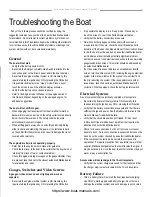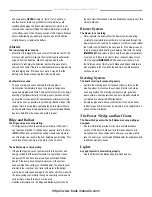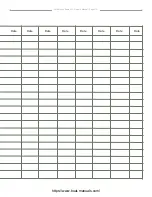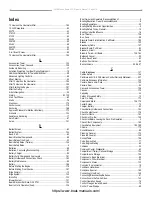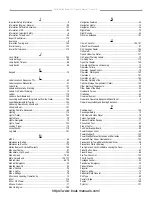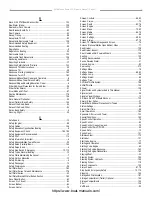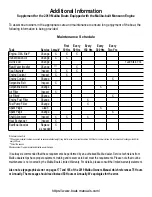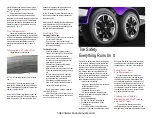
manufacturer’s information including:
• Recommended tire size
• Recommended tire inflation pressure
• Vehicle capacity weight (VCW—the maxi-
mum occupant and cargo weight a vehicle
is designed to carry)
• Front and rear gross axle weight rating
(GAWR—the maximum weight the axle
systems are designed to carry).
Both placards and certification labels are
affixed to the trailer. The recommended tire
pressure is on the tire, and the tire pressure and
load limit appear on the trailer label.
Understanding Tire Pressure
and Load Limits
Tire inflation pressure is the level of air
in the tire that provides it with load-carrying
capacity and affects the overall performance of
the trailer. The tire inflation pressure is a number
that indicates the amount of air pressure—mea-
sured in pounds per square inch (psi)—a tire
requires to be properly inflated.
The proper tire pressure for the trailer is
referred to as the “recommended cold inflation
pressure.” (As you will read below, it is difficult
to obtain the recommended tire pressure if your
tires are not cold.)
Because tires are designed to be used on
more than one type of vehicle, tire manufac-
turers list the “maximum permissible inflation
pressure” on the tire sidewall. This number is the
greatest amount of air pressure that should ever
be put in the tire under normal driving conditions.
Remember, however, that the vehicle manu-
facturer, not the tire manufacturer, determines the
correct tire pressure for the tires on your vehicle.
Checking Tire Pressure
It is important to check your trailer’s tire
pressure at least once a month or every 50
miles, whichever comes first, for the following
reasons:
• Most tires may naturally lose air over time
• Tires can lose air suddenly if you drive over
a pothole or other object or if you strike the
curb when parking
• With radial tires, it is usually not possible to
determine underinflation by visual inspection.
For convenience, purchase a tire pressure
gauge to keep in your tow vehicle. Gauges can
be purchased at tire dealerships, auto supply
stores, and other retail outlets.
The recommended tire inflation pressure
that manufacturers provide reflects the proper
psi when a tire is cold. The term cold does not
relate to the outside temperature. Rather, a cold
tire is one that has not been driven on for at
least three hours. When you drive, your tires get
warmer, causing the air pressure within them to
increase. Therefore, to get an accurate tire pres
-
sure reading, you must measure tire pressure
when the tires are cold or compensate for the
extra pressure in warm tires.
Steps for Maintaining Proper
Tire Pressure
Step 1: Locate the recommended tire pressure
on the trailer label.
Step 2: Record the tire pressure of all tires.
Step 3: If the tire pressure is too high in any of
the tires, slowly release air by gently
pressing on the tire valve stem with the
edge of your tire gauge until you get to
the correct pressure.
Step 4: If the tire pressure is too low, note the
difference between the measured tire
pressure and the correct tire pressure.
These “missing” pounds of pressure are
what you will need to add.
Step 5: At a service station, add the missing
pounds of air pressure to each tire that
is underinflated.
Step 6: Check all the tires to make sure they
have the same air pressure.
If you have been towing your trailer and
think that a tire is underinflated, fill it to the
recommended cold inflation pressure indicated
on your trailer label. While your tire may still be
slightly underinflated due to the extra pounds of
pressure in the warm tire, it is safer to drive with
air pressure that is slightly lower than the vehicle
manufacturer’s recommended cold inflation
pressure than to drive with a significantly under
-
inflated tire. Since this is a temporary fix, don’t
forget to recheck and adjust the tire’s pressure
when you can obtain a cold reading.
Tire Size
To maintain tire safety, purchase new tires
that are the same size as the trailer’s original
tires or another size recommended by the man-
ufacturer. At present, the trailer manufacturer is
not recommending any size differential than was
originally equipped. If you have any doubt about
the correct size to choose, consult with your
authorized Malibu or Axis dealer.
Tire Tread
The tire tread provides the gripping action
and traction that prevent your vehicle from
slipping or sliding, especially when the road is wet
or icy in general. Tires are not safe and should be
replaced with the tread is worn down to 1/16-of-
an-inch. Tires have built-in tread wear indicators
that let you know when it is time to replace your
tires. These indicators are raised sections spaced
intermittently in the bottom of the tread grooves.
When they appear “even” with the outside of
the tread, it is time to replace your tires. Another
method for checking tread depth is to place a pen-
ny in the tread with Lincoln’s head upside down
and facing you. If you can see the top of Lincoln’s
head, you are ready for new tires.
Tire Balance and
Wheel Alignment
To avoid vibration or shaking of the vehicle
when a tire rotates, the tire must be properly
balanced. This balance is achieved by positioning
weights on the wheel to counterbalance heavy
spots on the wheel-and-tire assembly. A wheel
alignment adjusts the angles of the wheels so that
they are positioned correctly relative to the vehicle’s
frame. This adjustment maximizes the life of your
tires and prevents your trailer from veering to the
right or left when driving on a straight, level road.
These adjustments require special equipment and
should be performed by a qualified technician.
Tire Repair
The proper repair of a punctured tire
requires a plug for the hole and a patch for the
area inside the tire that surrounds the punc-
ture hole. Punctures through the tread can be
repaired if they are not too large, but punctures
to the sidewall should not be repaired. Tires
must be removed from the rim to be properly
inspected before being plugged and patched.
Tire Rotation
Rotating tires from front to back and from
side to side can reduce irregular wear (for vehi-
cles that have tires that are all the same size).
The generally recommended rotation period is
every 5,000 miles.
Uniform Tire Quality Grading
System (UTQGS)
To help consumers compare tread wear
rate, traction performance and temperature
resistance, the federal government requires
tire manufacturers to grade tires in these three
areas. This grading system, known as the
Uniform Tire Quality Grading System, provides
guidelines for making relative comparisons when
purchasing new tires. You also can use this
information to inquire about the quality of tires
placed on new vehicles.
Although this rating system is very helpful
when buying new tires, it is not a safety rating or
guarantee of how well a tire will perform or low
long it will last. Other factors such as personal
driving style, type of car, quality of the roads,
and tire maintenance habits have a significant
influence on your tire’s performance and longevity.
Tread wear grades are an indication of a
tire’s relative wear rate. The higher the tread wear
number is, the longer it should take for the tread
to wear down. For example, a tire grade of 400
should wear twice as long as a tire grade of 200.
Traction grades are an indication of a tire’s
ability to stop on wet pavement. A higher graded
tire should allow you to stop on wet roads in a
https://www.boat-manuals.com/
Summary of Contents for Wakesetter 20VTX 2019
Page 1: ...https www boat manuals com...
Page 3: ...https www boat manuals com...
Page 6: ...https www boat manuals com...
Page 15: ...s a f e t y s a f e t y https www boat manuals com...
Page 16: ...https www boat manuals com...
Page 50: ...https www boat manuals com...
Page 73: ...https www boat manuals com...
Page 108: ...2019 Malibu Boats LLC Owner s Manual Page 95 https www boat manuals com...
Page 124: ...https www boat manuals com...
Page 125: ...h o w i t w o r k s h o w i t w o r k s https www boat manuals com...
Page 126: ...https www boat manuals com...
Page 154: ...2019 Malibu Boats LLC Owner s Manual Page 141 https www boat manuals com...
Page 155: ...t r a i l e r s t r a i l e r s https www boat manuals com...
Page 156: ...https www boat manuals com...
Page 171: ...https www boat manuals com...
Page 172: ...g e t r e a dy g e t r e a dy https www boat manuals com...
Page 180: ...2019 Malibu Boats LLC Owner s Manual Page 167 https www boat manuals com...
Page 182: ...https www boat manuals com...
Page 209: ...w a r r a n t y w a r r a n t y https www boat manuals com...
Page 210: ...https www boat manuals com...
Page 234: ...https www boat manuals com...
Page 235: ...https www boat manuals com...

